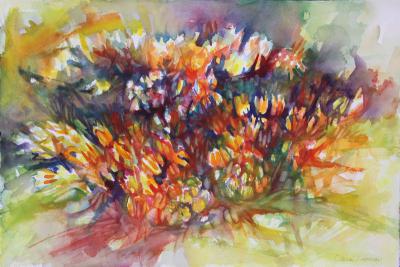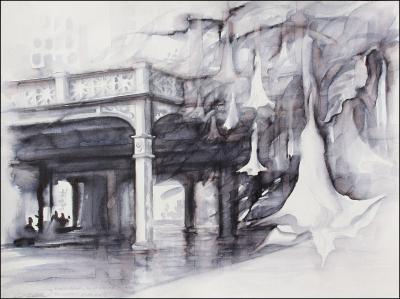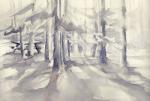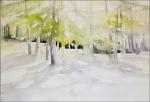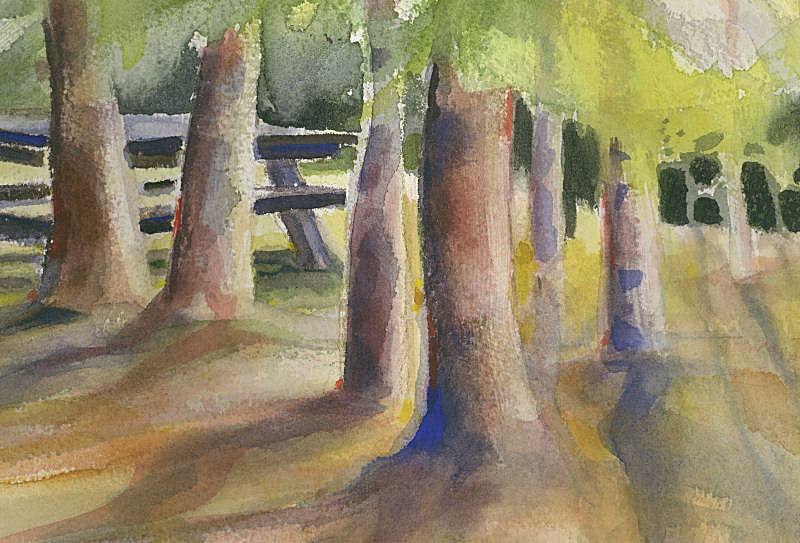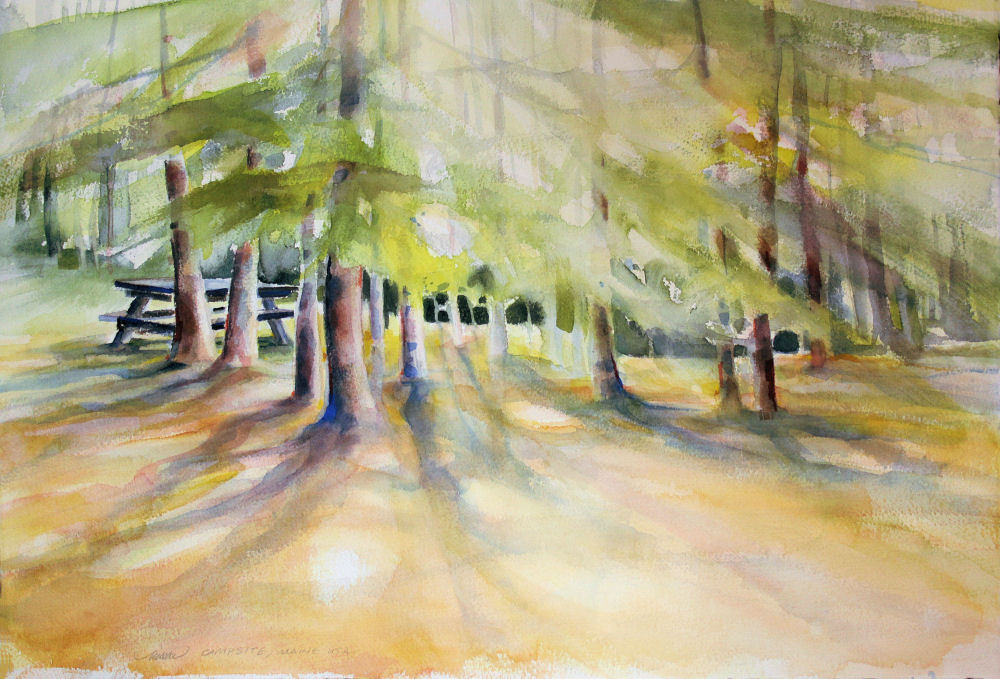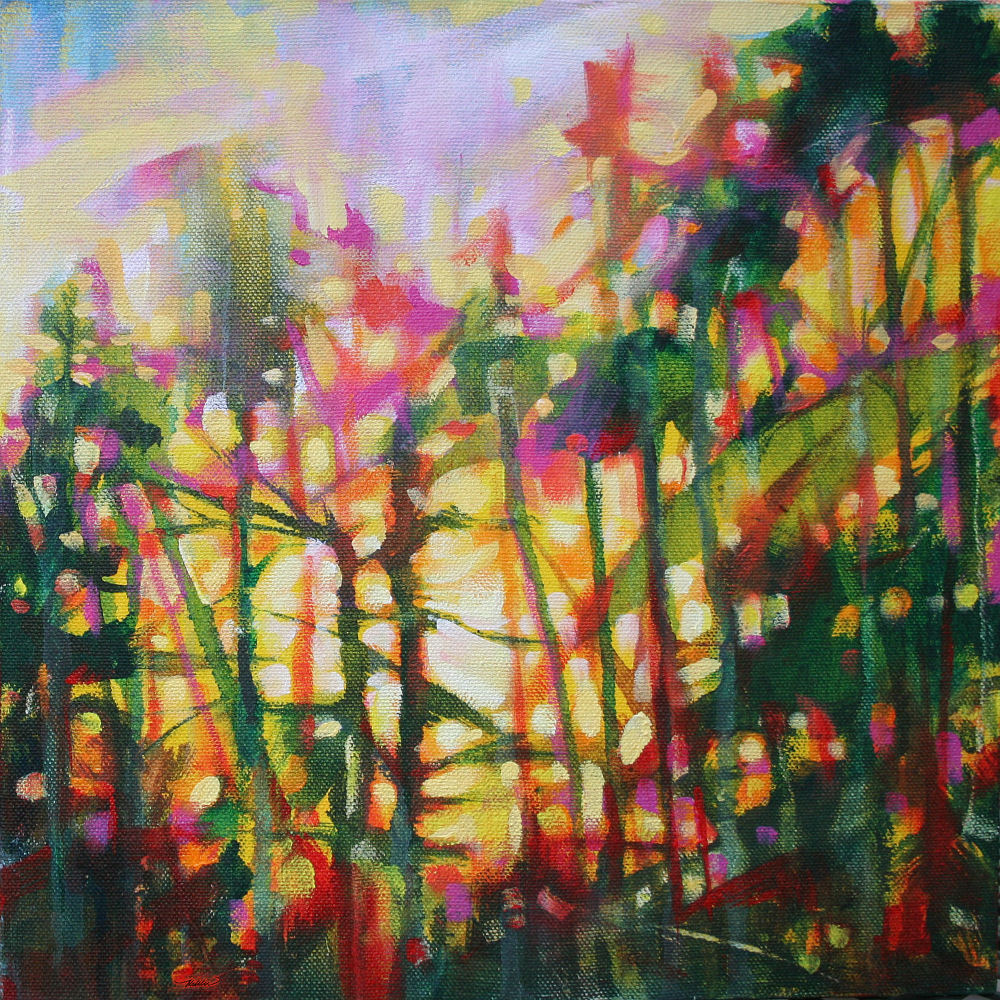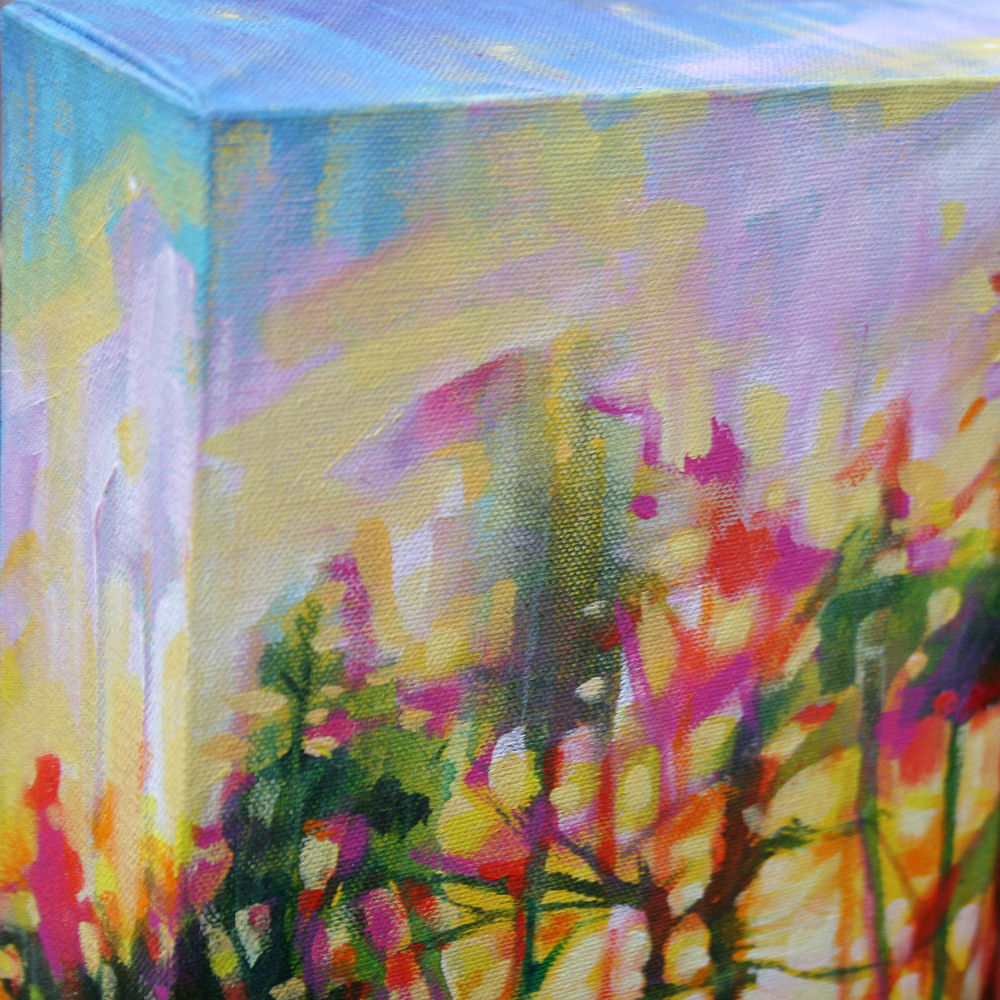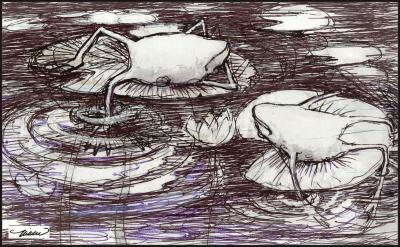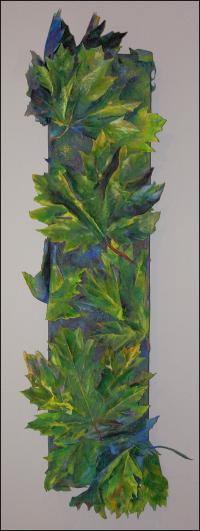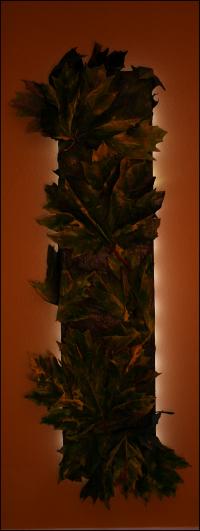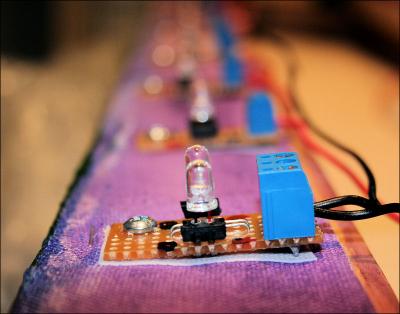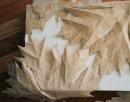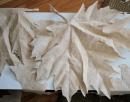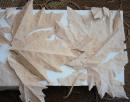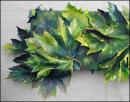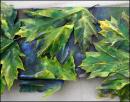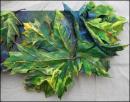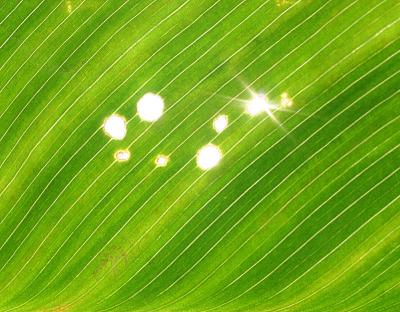summer
« Previous Entries Next Entries »Orange Milkweed
Saturday, November 21st, 2009
Orange Milkweed, Kentucky 15 x 22 inches watercolors on paper, sold
Driving from Texas to Ontario one summer I had to pull over to take photos and a closer study of the vivid orange bouquets growing beside the highway in southern Kentucky. The colors are irresistible, and this is not the first or last time I’ll portray this subject. All plants and trees contain medicinal and useful chemical properties in their leaves, stems, roots and flowers.
I looked up Orange Milkweed in the most informative books about plants, The Encyclopedia of Herbs and Herbalism edited by Malcom Stuart, which contains details about every plant I have ever sought to find information for. According to it, Appalachian Indians made a tea from the leaves to use during religious ceremonies. One common name for this plant is “Pleuracy Root”, as it is still useful to treat infections of the respiratory tract including pleurisy It is used as a diaphoretic, antispasmodic, carminative, expectorant. Color also has enchanting, supernatural energizing properties!
Angel’s Trumpet
Tuesday, November 10th, 2009
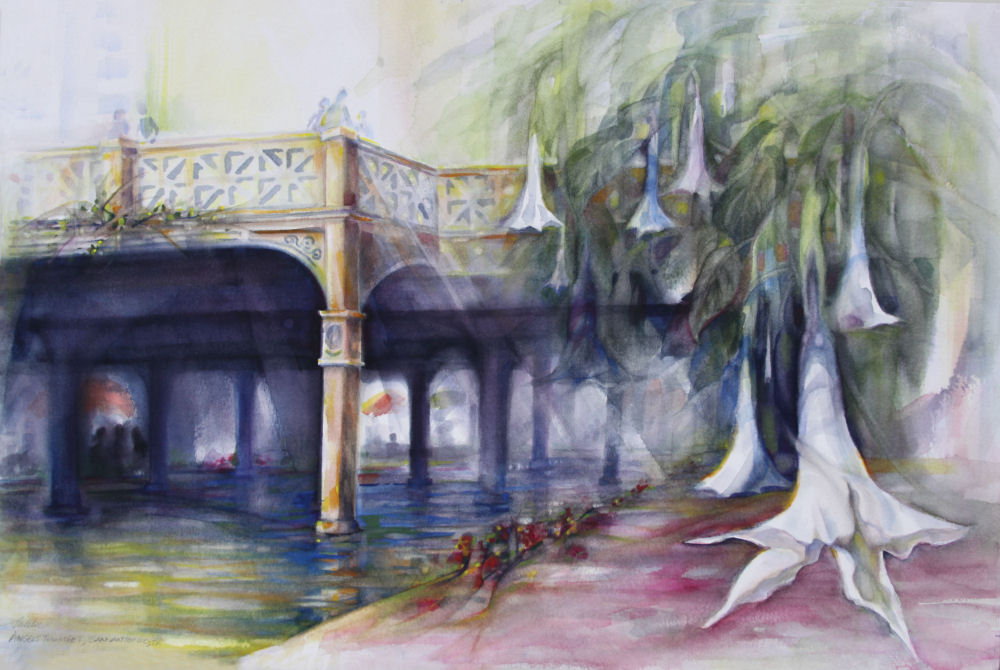
Angel’s Trumpet (Brugmansias) San Antonio Riverwalk, Texas – 14H x 22W inches watercolors on 140 lb. cold pressed premium, white mat
Value study
Thursday, November 5th, 2009
Angel’s Trumpet value study, San Antonio Riverwalk, Texas –12 x 16 inches Tombo pen wash on 140 lb. WC paper.
The Tombo pen is a two-in-one water-soluble marker available in colors as well as black. One tip is medium-fine and the other looks and behaves like a Chinese paintbrush, where thickness of lines can be controlled. What’s more difficult to control is that black once it’s on the page! It’s something to pay attention to when painting the colored version.
Preliminary studies are useful with watercolors because if, in trying to correct and re-work areas, the integrity of the paper is easily lost, especially on inexpensive papers. Still, on a traditional watercolor a lot can be done by adding water to pull out the dark where it’s not wanted, and push out areas of paint with dry brushes. Some places in this study have built-up 3D edges created by the paper bits because I pushed them around so much with a stiff brush to correct things, but traditionally this is not acceptable.
Actually, come to think of it, that might be interesting to deliberately sculpt the paper in strategic areas – like objects in the foreground – by saturating it with too much water, then while painting, brush the resulting paper bits into piles and mold them with a stiff brush. I may try that in the final colored painting of this scene. This proves once more that every single painting is an experiment to find ways to turn disadvantages and limitations into advantage and innovation.
Even though WC and Acrylics are water-friendly and watered-down acrylics is the method I use to start most canvas paintings, I’m noticing a few outstanding differences : 1) an off-balance composition seems to be more noticeable with WC, definitely not as correctable 2) improved attention to drawing, details and ultra-conscious 3) requires pre-planning and foresight to keep the work fresh and clean 4) commands enough confidence to swish the paint on quickly as if it was not planned.
San Antonio, Texas
Thursday, October 29th, 2009
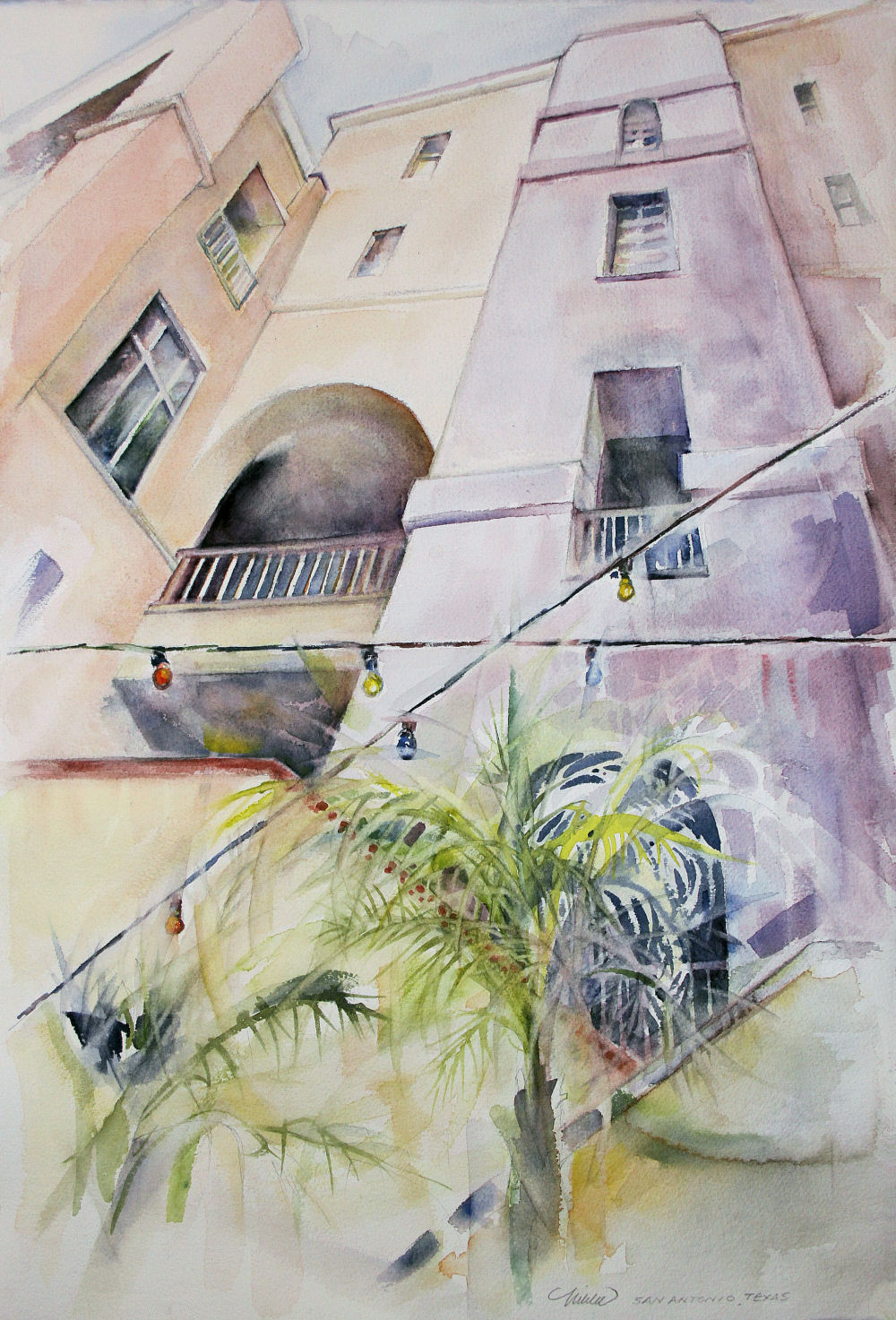
Buildings, San Antonio, Texas, 22H x 15W inches watercolors on 140 lb. acid free, cold pressed premium paper, white mat
The Campsite
Wednesday, October 21st, 2009
Thumbnails: 1) Value sketch using Payne’s Gray 2) Oct 21st in progress 3) finished, left detail. This is the 2nd week of the watercolor course offered by Jo Williams.
The Campsite, Maine, USA – 15 x 22 inches Watercolors on 140 lb. acid free cold press premium paper, 22H x 28W” professionally framed, dark cherry wood with brass title plate.
500X Gallery: Landscape
Tuesday, October 6th, 2009
Saint Catherine’s Sunset, Ontario, Canada – 11H x 11W x 3D acrylics on canvas, wrapped sides painted, showingOctober 1 0 – 31st, 2009 500X Gallery Open Show: Landscape, 500 Exposition Ave. Dallas, TX. Opening Reception Saturday, October 10th, 7:00 p.m. – 10:00 p.m.
Oxide Gallery 1st Year Anniversary celebration today, Tuesday October 6th, 6:00 p.m. – 9:00 p.m. Happy Anniversary Oxide Gallery!
I’ll be giving a demo on the use of Masking Fluid in acrylics paintings, so come and reveal one painting by helping to peel off the rubberized mask – I don’t even know what it looks like underneath, so it will be a surprise for all of us. Techniques on applying the fluid will be demonstrated on another painting already in progress. Three pieces accepted in the current show at Oxide Gallery are:
Try Frog Asana
Monday, September 21st, 2009
Frog Asana, my suggestion for a new Yoga posture: the Frog Pose! Ink drawing on foolscap, tidied with digital pen
Takin’ it easy
Friday, June 12th, 2009
There is a time for work and a time to relax…wow. This truck sharing the road on the way back from North Carolina was not parked…this guy was driving 70 mph down the highway! I’m just back from NC then up to Alberta soon, so no new artwork to post until about the end of July.
What Bigleaf Maples Do At Night
Monday, May 25th, 2009
What Bigleaf Maples Do At Night, 57H x 20W x 4D inches muslin, glue, acrylics on canvas wrapped over custom-built stretcher frame. LED light system in back.
Alain, my husband, signed his name on this also, because he spent the entire week designing, soldering and wiring a system of 30 LED lights for the back. He was not impressed with the eight inadequate push-lights I was initially going to use to create this Day- Night Art. The electric source is a rechargeable 12 volt battery placed neatly in the back, with an easily accessible on-off switch in the lower left corner. He’s not thrilled to ever create another, so it looks like I’ll be learning a little about soldering and electronics, because there are plans to transform the other two canvases exactly the same size as this one. Originally l hoped it could hang in any of four orientations, but that was revised due the battery pack in the back. Thank you Alain for making this piece what it is!
______________________The original blog posts; process:___________________
Nov. 17th, 2008: While finishing the final stages of Sun Shower #4, at this point more study than stroke, I’ve started on the next piece… a bit of mystery thrown into this one just for fun. Hint: Step 1 – Unbleached muslin is painted with glue; place over top parchment paper and turn or lift frequently so it doesn’t stick. Nov. 18th: Step 2– When dry the muslin becomes stiff and can be crumpled, pinched and maneuvered to create 3D textures.
Nov 18th, aft. Step 3 – OK, enough guessing. I have three beautiful sturdy 36 x 12 x 3 inch canvases, hung vertically or horizontally. Each one will have a 3D design of life-sized leaves created with the stiff muslin. This one is of Large Leaf Maples seen on salt Spring Island, B.C. when we were there last summer. They are really this big – about 15 inches across! On these canvases, all dimensional surfaces will be considered; the front, the sides, and possibly some sticking out from the back. Everything will be primed before painting and I love Virginia’s idea to use glue as a resist for the leaf veins. In the above three images the design is still in planning stages.
Nov. 19th – A few thoughts before continuing work: this could be as simple as a sillhouette or painted realistically, still haven’t decided..maybe a compromise of the two, on the abstract side of things. Putting lights in the back could be interesting too, as in the recent Zen Garden #8 but would like to come up with something that does not have a distracting cord.
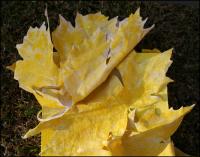 Nov.21st – Seen here, the leaves have a splotchy base coat of Hansa Yellow Deep, a color chosen because when it is so vibrant when it peeks through built up layers of other colors. Now that the entire piece has color though, I think I prefer the sculptural purity of the unpainted sillhouettes better – something to remember for similar work in the future.
Nov.21st – Seen here, the leaves have a splotchy base coat of Hansa Yellow Deep, a color chosen because when it is so vibrant when it peeks through built up layers of other colors. Now that the entire piece has color though, I think I prefer the sculptural purity of the unpainted sillhouettes better – something to remember for similar work in the future.
The weight of tinted primer and each application of acrylics makes the fabric limp from of the paint, meaning the creasing process needs to be done all over again once it dries, even on successive layers. Because of this I need to slow down and be more gentle with the painting process also. It’s funny how you can overlook things like that when you are ten steps ahead with anticipation for a new project; things always take much longer than you imagine. There is going to be a lot of stopping and starting with this one, which is exactly how overlapping projects occurs.
Also: looking forward to a day-long workshop tomorrow, learning about Encaustic painting with Deanna Wood. Encaustics is an ancient process of painting with beeswax and natural resins. Not usually a “workshop” kind of Artist because I’m too greedy with my work-time, but this is one of those things that’s best learned from an expert. Am bringing a fabric leaf to the class to see how it could be incorporated and if this entire. Large Leaf Maples piece could benefit.
______________________________
All posts and comments for this piece are now combined.
Submitted on 2008/11/18 at 11:48am
If you don’t want to see the seed bits in the muslin, you can get unbleached muslin without the seeds.
_______________________________
Submitted on 2008/11/18 at 1:03pm
OK Lynda, thanks for offering this valuable tip. With regard to what’s in mind for this project, the rawness of the fabric will provide extra texture, but others may want to know that finer quality muslin is available.
Nikki
_______________________________
Submitted on 2008/11/18 at 1:53pm
Hmmm…looks like a resist process to me. Is it a mask? You are a very adventurous soul!
Virginia Wieringa
_______________________________
Submitted on 2008/11/18 at 2:06pm
Nope, not a mask or resist…at least the glue wasn’t initially going to be used as a resist, but once again I owe thanks for the tip via a viewer’s comment – thanks Virginia! It’s true, glue can be used on anything as a paint resist, usually on wood it works similar to crackle glaze (ask me how if anyone is interested). I haven’t tried that technique on raw fabric yet though and for what I have in mind, painting extra glue in strategic places could produce some interesting effects. Let’s see…
Nikki
_______________________________
Submitted on 2008/11/19 at 1:16am
This is great Nikki. I’ll be back tomorrow to see how this project is coming along.
Jim Drury
_______________________________
Submitted on 2008/11/19 at 4:12pm
Hi Nikki
This is getting really interesting, can’t wait to see the finish project
Elizabeth
_______________________________
Submitted on 2008/11/19 at 7:07pm
Thanks for staying tuned Dad and Elizabeth, I also can’t wait to see the finished project – it’s always a mystery even if I think I know what I’m doing.
Nikki
_______________________________
Nov.27: What Large Leaf Maples Do At Night, detail images of 12 x 36 x 3 inches Muslin, glue, acrylics on wrapped canvas. As seen here I imagined the leaves glowing in the moonlight, which took me to the idea of turning it into a piece that can be viewed differently in a dark corner or at night so the sculptural sillhouette shows best.
Since Saturday’s Encaustics workshop I’d like to try another sculptural piece doing the whole thing with 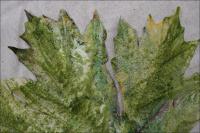 Encaustics tecniques, see right sample. Beeswax doesn’t adhere to acrylics though, so another will need to be planned with that medium in mind right from the start.
Encaustics tecniques, see right sample. Beeswax doesn’t adhere to acrylics though, so another will need to be planned with that medium in mind right from the start.
A New Solar System
Wednesday, May 13th, 2009
Not much artwork to be posted this past week or for the next two weeks because of all the printing and finalizing details for The Majesty of Trees, so I might as well post another link to the website and promote the show one more time.
Meanwhile, taking photos is still a daily activity because there’s always something beautiful somewhere, and it sure is a nice way to take a break..
« Previous Entries Next Entries »

